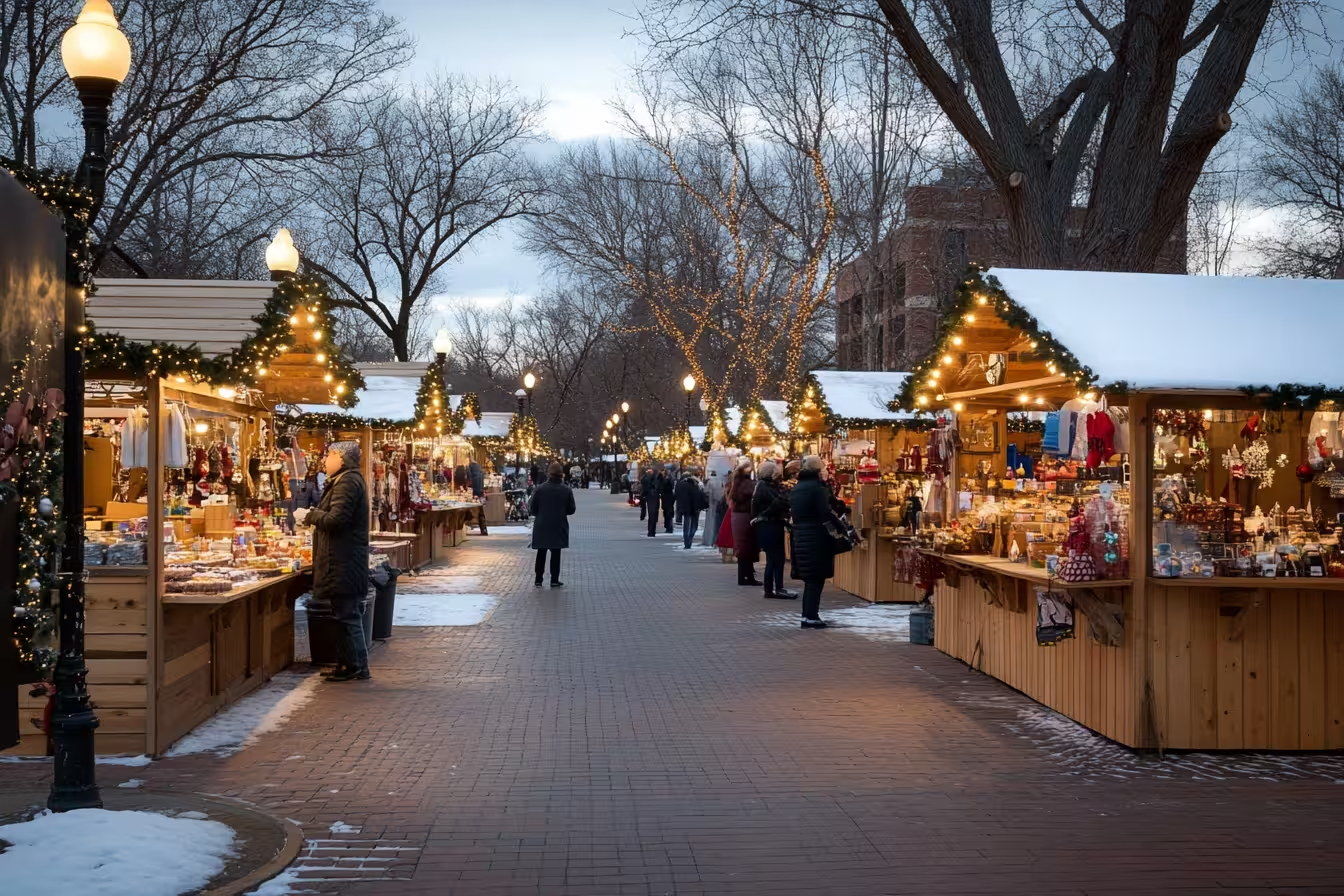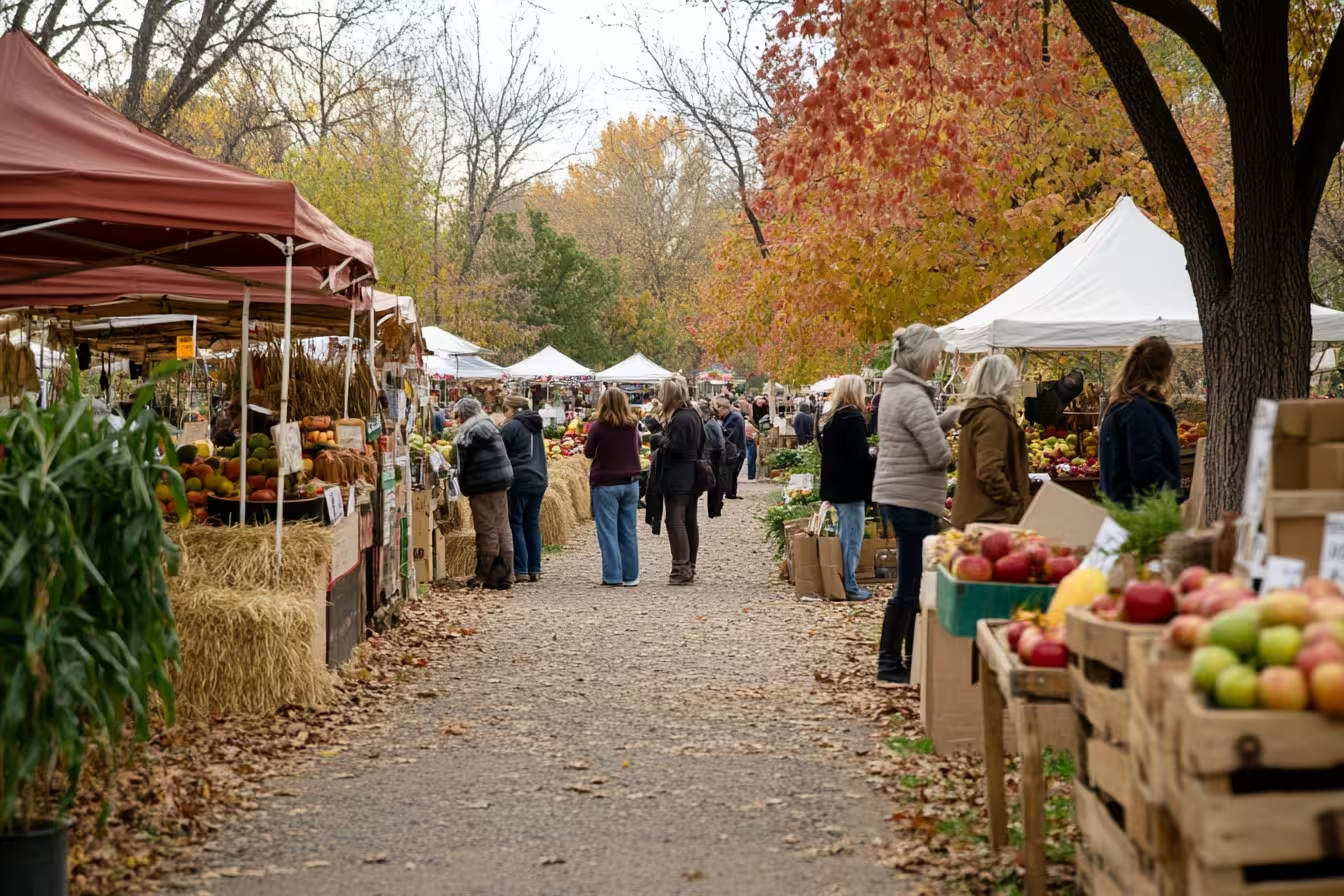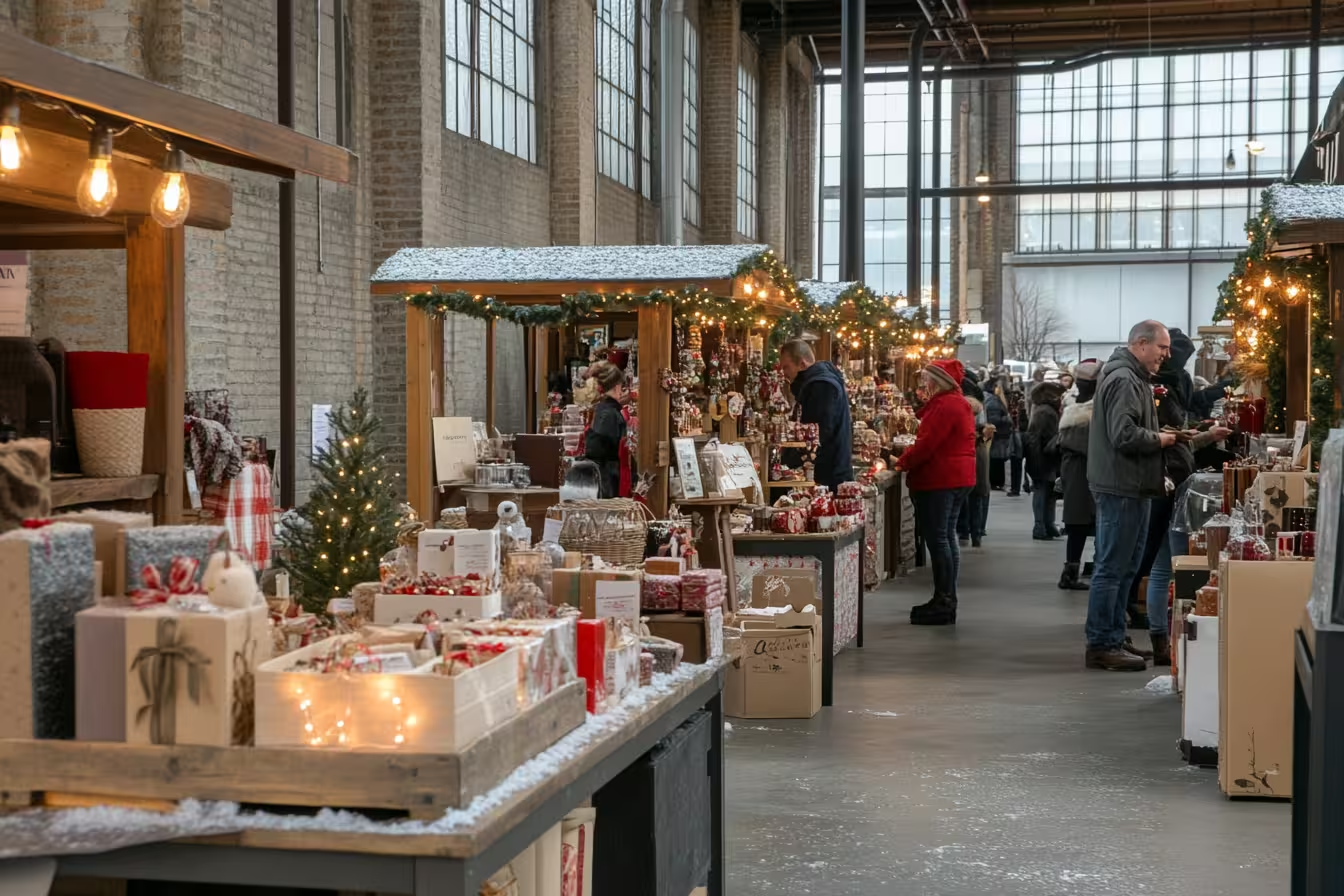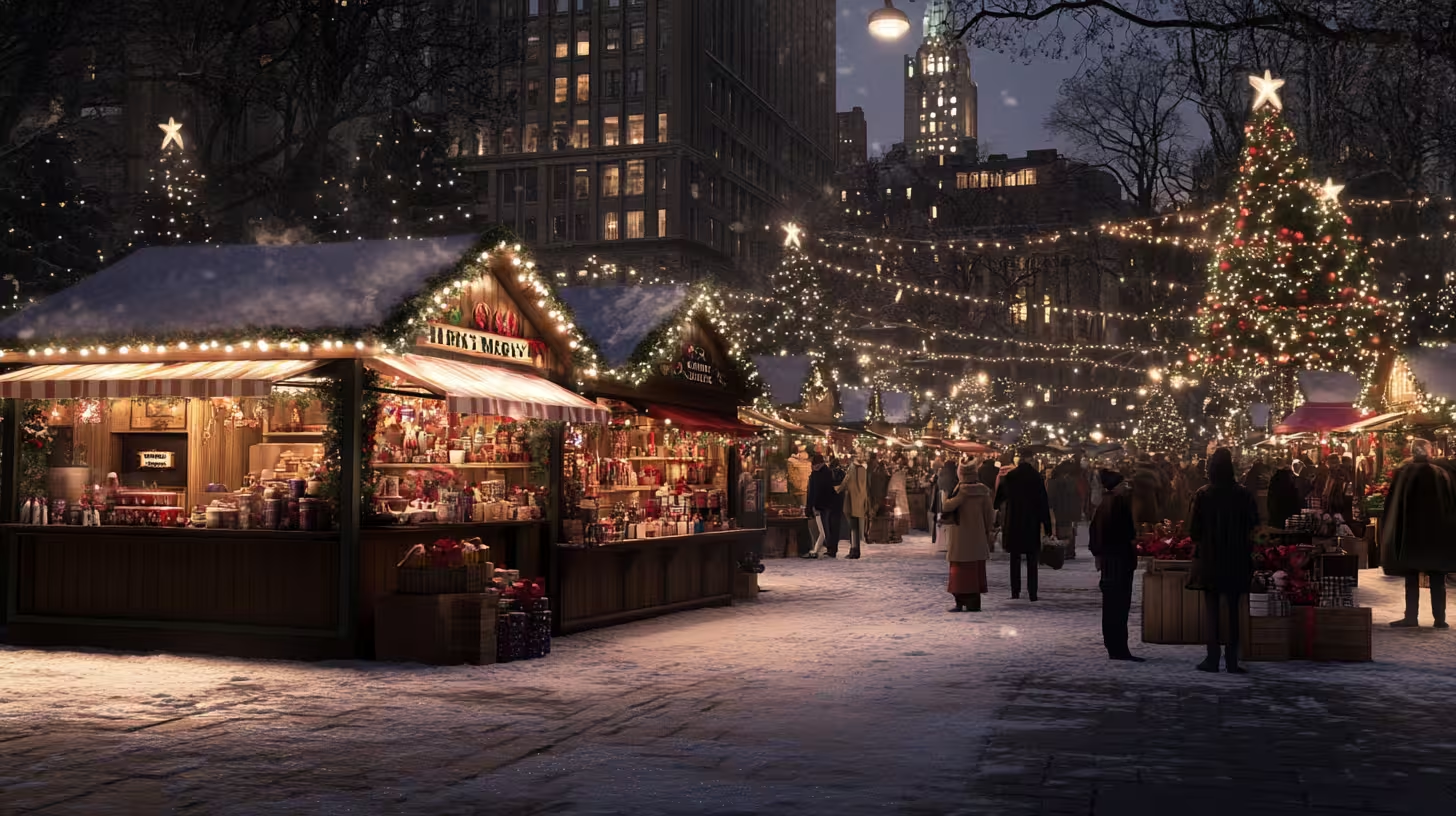In city centers, fairgrounds, and events centers across America, holiday markets, autumn boutiques, and seasonal activities bring communities together and infuse neighborhoods with vibrant, festive spirit. From cider mills to arts and crafts markets, these attractions offer city residents and visitors alike a chance to experience a slice of rural charm within an urban setting. For urban planners, the rise of holiday-themed markets and activities presents unique opportunities to engage communities, support local economies, and foster cultural exchange.

Holiday Markets: Where Tradition Meets Urban Culture
Urban holiday markets are an ever-growing trend in cities worldwide. Inspired by European traditions like der Weihnachtsmarkt, these markets are characterized by charming stalls selling handcrafted gifts, decorations, and seasonal treats. In cities across the U.S., from New York to California, communities have embraced this model, creating winter wonderlands with twinkling lights, festive music, and the inviting aromas of hot cider and chocolate wafting through the air. These markets are more than shopping destinations—they are experiences that invite people to slow down, enjoy the season, and reconnect with holiday traditions in a cozy, festive setting.
Bringing Festive Cheer to City Centers
Holiday markets often host a mix of local artisans, small businesses, and food vendors, offering unique products that reflect the community’s culture and character. From handmade crafts and artisanal foods to one-of-a-kind gifts, these markets support local creativity and entrepreneurship, giving residents and tourists a chance to discover items they might not find in mainstream stores. This local focus brings a personal, community-oriented atmosphere to city centers and creates a stronger connection between residents and the artisans who make these items. Visitors are not only shopping; they are supporting their neighbors and experiencing the artistry and passion behind each product.
Economic and Cultural Benefits for Urban Spaces
For community leaders, holiday markets are an effective strategy for boosting both the cultural appeal and economic vitality of downtown areas. These markets attract tourists and locals alike, drawing them into urban spaces they may not usually frequent, particularly during the colder months. As people flock to holiday markets, they also tend to visit nearby restaurants, cafes, and other businesses, leading to increased revenue for a broad range of local enterprises. By creating seasonal attractions like holiday markets, economic development helps generate a consistent flow of foot traffic, which can have lasting economic impacts even after the market season ends.
Beyond the economic benefits, holiday markets enrich the cultural fabric of cities. They celebrate tradition while creating new ones, encouraging people to gather and connect in public spaces. These markets often feature live music, local performances, and activities that invite participation from all ages, enhancing the city’s cultural vibrancy and fostering a sense of community pride.
Creating Tradition and Warmth in Urban Environments
In bustling urban environments, holiday markets offer a welcome respite from the fast-paced routine of city life. The sights, sounds, and smells of these festive markets bring a sense of warmth and nostalgia, offering visitors an experience that feels simultaneously timeless and fresh. Seasonal decorations, light displays, and cozy seating areas create a festive ambiance that invites people to linger, enjoy a warm drink, and celebrate the season in a communal setting. These moments of togetherness bring a rare and valuable sense of connection to city residents, building a feeling of tradition within an urban landscape.
Holiday markets also contribute to the mental well-being of city dwellers by fostering joy and relaxation. Studies have shown that seasonal activities and social gatherings can significantly reduce stress and enhance happiness, especially during the winter months when people are more prone to feelings of isolation. Urban planners who prioritize spaces for such seasonal markets are, in essence, creating opportunities for residents to engage in a richer, more connected city life, celebrating both community and the festive season.
By incorporating holiday markets into local economic development, cities can create lasting traditions that resonate with residents and visitors year after year, making these spaces destinations that people look forward to revisiting as part of their seasonal celebrations.
Roc Holiday Village in upstate Rochester, New York, is among the most popular holiday markets across the United States. As described in USA Today, this event offers a variety of wares and gift items from more than two dozen vendors who rotate weekly. Guests can also participate in other festive activities like ice-skating, visits with Santa, live entertainment, and games. They even have an igloo tent.
The Denver Christkindlmarket outgrew it’s 16th Street Mall location and now takes over Civic Center Park from Thanksgiving to Christmas. Denver’s event is an authentic, German-style holiday market, hosting local and European craft and food vendors, along with entertainment for the entire family. Denver Christkindlmarket is produced by the German American Chamber of Commerce – Colorado Chapter.
Even in warmer climates along the Rio Grande, WinterFest in El Paso, Texas, offers a festive destination each holiday season with more than a million holiday lights and a 55-foot Christmas tree. The holiday market features vendors offering unique wares, fresh produce, and tasty local treats, along with live music and ice-skating.

Autumn Boutiques and Apple Orchards: Seasonal Events for All Ages
Fall offers an ideal season for outdoor gatherings that celebrate the harvest and cooler weather. Autumn boutiques and apple orchards appeal to families, tourists, and city dwellers looking for unique seasonal experiences close to home. These events bring a sense of seasonal charm to urban spaces, allowing city residents to connect with traditions often associated with rural life. Pop-up boutiques and apple orchards create inviting atmospheres, showcasing local produce, crafts, and artisanal goods that capture the essence of autumn.
Embracing Nostalgia with Hayrides and Apple Picking
Activities like hayrides, apple picking, and visits to cider mills offer nostalgic experiences that remind urban residents of the simple joys associated with fall. These activities often evoke childhood memories or create new traditions for families and friends to cherish year after year. Hayrides, typically set up with cozy seating and blankets, allow visitors to enjoy the beautiful autumn landscape. Apple picking offers a hands-on experience where people can select their own fresh fruit straight from the orchard, encouraging an appreciation for the labor involved in harvesting.
Cider mills and seasonal food stands further enhance these events by providing classic autumn flavors like warm apple cider, caramel apples, and pumpkin treats. These experiences bring people closer to nature, offering a break from the fast pace of city life and giving them a chance to savor the season. For many, these are rare opportunities to engage in rural-inspired activities within a city, creating a unique blend of urban convenience and countryside charm.
Fostering Connection to Agricultural Roots
These seasonal gatherings not only entertain but also serve as a reminder of the region’s agricultural heritage. By participating in apple picking, cider-making, and harvest festivals, city residents experience a closer connection to farming traditions and gain a greater understanding of where their food comes from. This awareness fosters respect for local farmers and the seasonal nature of produce, promoting sustainable consumption and supporting agricultural traditions in an accessible way.
For families with young children, these experiences are educational as well as enjoyable. Children get a firsthand look at farming processes, see the importance of seasonal cycles, and learn about the hard work involved in producing food. Such activities encourage urban communities to reconnect with the land and instill a sense of stewardship toward natural resources.
Opportunities for Economic Development: Pop-Ups and Local Orchards
Community leaders have a unique opportunity to incorporate seasonal attractions into city environments as an economic development tool. When developers and urban planners designate spaces for pop-up autumn boutiques, small orchards, or temporary cider mills, community leaders can introduce these rural traditions in an urban setting, making seasonal festivities more accessible. These pop-up spaces add vibrancy to neighborhoods, attract foot traffic, and create a more lively, festive ambiance in city parks, plazas, or other communal areas.
Economic development and planning professionals can also partner with local vendors and artisans to establish rotating market days or seasonal festivals that feature autumn products and handmade crafts. This approach not only supports local businesses but also encourages urban residents to explore their neighborhoods and engage with local culture in new ways. Setting up these spaces in easily accessible areas within the city allows people to experience the best of the season without traveling far, adding convenience to the charm of autumnal festivities.
Supporting Local Farmers and Artisans
Collaborating with local farmers, artisans, and small businesses to create seasonal events strengthens the community and supports the local economy. Farmers can showcase their produce and educate people about seasonal crops, while artisans offer unique, handcrafted items that celebrate the spirit of fall. This collaboration builds relationships between urban consumers and local producers, fostering a strong sense of community support.
For artisans, autumn boutiques provide a platform to reach new customers and share their creative work. Jewelry makers, woodworkers, painters, and other artists have the chance to display their crafts in a seasonal, lively setting, creating an appealing alternative to traditional retail spaces. By supporting these makers, cities can build a more diverse local economy that values craftsmanship and locally sourced products. Seasonal markets also give visitors a chance to find distinctive gifts and decor that reflect the beauty and warmth of autumn, often in a way that mass-produced items cannot match.
Overall, integrating autumn boutiques, apple orchards, and seasonal markets into urban spaces provides an enriching experience for all ages. These events enhance community bonds, support local businesses, and bring an authentic seasonal charm to city life, creating memorable experiences that residents look forward to every fall.

Embracing the Community Spirit: Hayrides, Hot Chocolate, and Craft Markets
Integrating seasonal activities such as hayrides, hay bales, and corn stalk displays into public spaces provides city residents with a charming and authentic way to celebrate the changing seasons. These experiences offer more than just seasonal decoration; they create environments where people from all walks of life can come together to relax, socialize, and reconnect. By bringing rural traditions into the city, urban planners can create a sense of community that is often challenging to foster in urban environments.
Designating Spaces for Hayrides and Seasonal Decor
Designating specific areas for hayrides and creating scenic displays with corn stalks, pumpkins, and bales of hay adds a festive touch to city parks and public spaces. These elements evoke the warmth and simplicity of rural autumn traditions, providing a break from the city’s usual sights and sounds. Scenic spots featuring seasonal décor allow residents to enjoy the beauty of fall without needing to leave the city, making it accessible to everyone.
Hayrides, in particular, are a popular and interactive way to experience the season. Urban planners can work with local farms or businesses to offer hayrides in designated areas, either as part of an event or as a regular attraction during the autumn months. By incorporating routes through scenic parts of the city, such as parks or near waterfronts, these hayrides give residents a unique perspective on familiar landscapes, helping them appreciate their city in a new light.
Decorating public spaces with corn stalks, gourds, and other fall elements transforms these areas into festive, photo-worthy spots that residents and tourists alike will want to visit. These seasonal displays create lasting memories and make city parks a go-to destination during the autumn months.
Creating Cozy Atmospheres with Warm Drinks
Warm drinks like hot cider and hot chocolate are key to creating a cozy and welcoming atmosphere at seasonal markets and events. Nothing quite captures the essence of fall like a steaming cup of cider or hot chocolate, especially on a crisp autumn day. Local vendors offering these seasonal beverages add to the sensory experience, filling the air with comforting aromas that attract visitors and enhance the festive feel of the market.
For many, gathering around with friends or family to enjoy a warm drink embodies the spirit of fall. The act of sipping hot cider or cocoa in a communal setting encourages people to pause, unwind, and savor the moment. It also creates an inviting setting for families, couples, and friends to connect and make new memories. Seasonal drink offerings also provide an excellent opportunity for local businesses to showcase their creativity, such as spiced apple ciders, pumpkin lattes, or specialty hot chocolates with unique toppings. These small touches add character to the market and make the experience even more memorable for visitors.
Partnering with Local Vendors for Inclusive Market Spaces
Economic developers can enhance these seasonal events by partnering with local vendors to establish temporary hot drink stands, craft stalls, and food booths. By doing so, they create inclusive spaces that cater to the tastes and interests of the community, offering something for everyone. These partnerships support local businesses, giving them a valuable platform to reach new customers and showcase their products in a festive, high-traffic setting.
Craft markets are a particularly popular addition to these seasonal events, as they provide a space for local artisans to sell handmade goods that reflect the essence of fall. From knitted scarves and handmade candles to artwork and seasonal decor, craft markets allow residents to shop for unique items and gifts that celebrate the season. These markets are more than just shopping venues; they are places where residents can engage with artisans, learn about their craft, and feel a deeper connection to the community.
Urban planners should be sure their zoning and other regulations provide for market space. By strategically placing markets and vendor stands near gathering areas or along pathways, planners create a seamless flow that encourages exploration and social interaction. This setup ensures that the market feels welcoming and accessible, making it easy for people to wander, browse, and enjoy all the seasonal offerings without feeling rushed or crowded. These inclusive market spaces embody the community spirit, bringing together residents of all ages and backgrounds in a festive, supportive environment.
Enhancing Community Bonds through Seasonal Traditions
The incorporation of hayrides, cozy drink stations, and craft markets doesn’t just add seasonal flair; it strengthens community bonds. Residents have a chance to connect, exchange stories, and engage in shared experiences, which fosters a sense of belonging and pride in their community. Seasonal activities create a shared rhythm, giving people a reason to come together year after year and making these gatherings a cherished tradition within the urban landscape.
For local leaders, organizing these events and designating spaces for seasonal gatherings is an opportunity to create a more cohesive community. By focusing on inclusivity and celebrating the charm of the season, planners can offer a space where everyone feels welcome, promoting stronger connections among neighbors and enhancing the city’s overall quality of life.

Gift Markets and Arts & Crafts: Supporting Local Artisans and Businesses
Holiday and autumn markets provide an ideal platform for local artisans to showcase their handmade crafts and unique items, ranging from jewelry and pottery to textiles and home decor. These markets celebrate the skill and creativity of local artists, allowing them to connect with customers in a personal, interactive setting. Visitors appreciate the chance to find unique, carefully crafted pieces that differ from mass-produced items, adding a personal touch to their holiday shopping experience.
Creating a Marketplace for One-of-a-Kind Gifts
Arts and crafts markets give residents and tourists alike an opportunity to purchase one-of-a-kind gifts that carry a story and meaning. Each piece reflects the artisan’s creativity, skill, and cultural background, which makes it more than just an item for sale; it’s a connection to the maker’s craft and tradition. Shoppers are often able to meet the artisans, learn about their work, and discover the inspiration behind each creation. This personal interaction transforms the shopping experience into a memorable event, creating a deeper appreciation for the time, effort, and passion that goes into each handmade item.
Buying locally crafted gifts also fosters a sense of pride and support within the community. Residents enjoy knowing that their purchases directly benefit local artists and small business owners. This local focus not only strengthens the local economy but also builds community bonds by reinforcing the idea that city residents and artisans are working together to enrich the cultural fabric of their environment.
Enhancing the Urban Holiday Shopping Experience
Gift markets bring an artisanal touch to the urban holiday shopping experience, offering a unique and welcoming alternative to larger, impersonal retail outlets. Unlike shopping malls and chain stores, holiday markets have an inviting, festive atmosphere filled with the warmth of holiday lights, seasonal decorations, and music. Shoppers can enjoy browsing stalls in an open-air environment, savoring the sights and sounds that create a distinctive holiday ambiance. The artisanal focus also attracts visitors who seek high-quality, unique products as opposed to mass-produced goods.
This special shopping environment appeals to a diverse audience, from families and tourists to collectors and gift-givers looking for something truly unique. Many urban gift markets also feature food stalls, live music, and hands-on workshops, making them a destination where people can spend an afternoon enjoying the holiday season. By creating an enjoyable, relaxed atmosphere, these markets elevate the holiday shopping experience beyond the transaction itself, fostering a sense of community celebration.
Designating Accessible Spaces for Seasonal Markets
For urban planners, supporting arts and crafts markets during the holiday season aligns with broader economic and cultural goals. By designating accessible, central locations within the city for these markets, planners can maximize visibility and foot traffic, attracting both residents and tourists. This accessibility ensures that all community members, regardless of transportation options, can easily visit and enjoy these seasonal markets.
Furthermore, seasonal markets play a significant role in enhancing the city’s unique character and cultural appeal. These markets contribute to a lively city center, drawing people into shared spaces that celebrate the holiday season and showcase the talent of local artisans. The visual impact of festive stalls and decorations brings a sense of warmth and charm to urban landscapes, encouraging residents and visitors to view the city as a welcoming place to gather and celebrate.
Nurturing Local Talent and Supporting Economic Growth
Urban gift markets offer more than just a space for artisans to sell their goods; they nurture local talent and support the city’s economic growth by creating opportunities for small business owners to thrive. Many artisans rely on seasonal sales to sustain their work, and holiday markets provide an essential boost in exposure and revenue during peak shopping periods. By offering spaces specifically for these artisans, cities can create an ecosystem that values and invests in local creativity, ensuring that small businesses have the resources they need to succeed.
Supporting local artisans in this way is also a means of preserving cultural heritage, as many handmade crafts reflect traditional skills passed down through generations. When city residents buy from these artisans, they contribute to the preservation of cultural techniques and artistic knowledge that might otherwise fade away in the face of mass production. The economic support gained from holiday markets allows artisans to continue their work and inspire future generations of makers.
In addition, gift markets create seasonal jobs for market staff, organizers, and vendors, further boosting the local economy. They often attract visitors from neighboring cities, increasing tourism revenue and adding to the city’s reputation as a vibrant, creative destination. This influx of visitors benefits not only artisans but also nearby businesses, such as cafes, restaurants, and shops, as holiday market-goers spend time in the area.
Building Community Pride and Creating Memorable Experiences
One of the most valuable aspects of gift markets is their ability to foster community pride and create memorable experiences that residents cherish. By hosting seasonal events that emphasize local talent, cities create spaces that residents can feel proud of, reinforcing the identity and character of the community. Many families and friends make visiting holiday markets an annual tradition, strengthening the bond between residents and their city while supporting local businesses.
By integrating gift markets into urban spaces, cities can provide an enriching, festive experience that highlights the beauty of handmade craftsmanship and strengthens the connection between urban life and local culture. Seasonal markets not only enhance community bonds but also contribute to a city’s identity, creating memories and traditions that residents look forward to year after year.

Conclusion: Creating Vibrant Urban Spaces Through Seasonal Events
The integration of holiday markets, autumn boutiques, and seasonal attractions into local economic development and urban planning is more than just a trend—it’s an opportunity to enhance the urban experience, build community, and support local economies. By providing spaces for activities like hayrides, hot cider stands, and arts and crafts markets, local leaders can create vibrant, seasonal environments that encourage social interaction and celebrate the cultural richness of their cities and regions.
As cities continue to grow, these seasonal attractions offer urban residents a taste of rural traditions and seasonal celebrations, bringing a touch of warmth and community spirit to the urban landscape.
Read More
Books:
- “Markets and the City: Essential Readings in Urban Planning” by Brendan Gleeson – An insightful collection exploring how markets shape urban spaces and influence social dynamics within cities.
- “Placemaking: The Art and Science of Building Community” by Lynda H. Schneekloth and Robert G. Shibley – This book discusses methods for creating engaging public spaces, with a focus on community-building strategies relevant to urban planners.
- “The Urban Farmer: Growing Food for Profit on Leased and Borrowed Land” by Curtis Stone – Although focused on urban agriculture, this book provides valuable insights for planners looking to integrate local food production and seasonal markets into urban spaces.
- “Seasonal Markets: Their Role in Cities” by Anna Greenspan – A deep dive into the cultural and economic impact of seasonal markets in urban settings, perfect for planners and market organizers alike.
Websites:
- American Planning Association (APA) – Offers numerous resources on urban planning, with case studies and insights into the integration of public markets within urban spaces.
Website: www.planning.org - Project for Public Spaces (PPS) – This site focuses on placemaking and public spaces, offering guides on creating community-oriented market spaces and revitalizing urban areas.
Website: www.pps.org - LocalHarvest – A comprehensive site for finding local farmers’ markets, u-pick orchards, and seasonal events, supporting connections between residents and local producers.
Website: www.localharvest.org - Urban Land Institute (ULI) – Provides resources for urban planners and community developers, with information on sustainable markets, public spaces, and urban revitalization projects.
Website: www.uli.org

